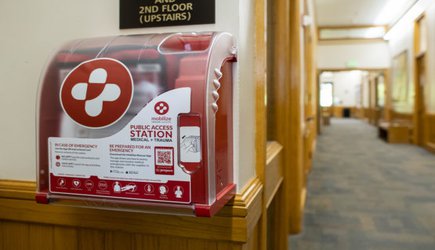Stanford increases access to medical and trauma supplies across campus

The Stanford University Department of Public Safety has established a new campus program that will allow bystanders who are not necessarily medically trained to treat people with traumatic injuries in the minutes before emergency responders arrive on the scene.

These red plastic cases containing emergency medical kits have been installed in dozens of locations across campus. (Image credit: L.A. Cicero)
Under the program, Stanford has installed Public Access Medical + Trauma Stations – wall-mounted red plastic cases– in 35 locations across campus, including the History Corner (Building 200) on Lasuen Mall, Tresidder Memorial Union on Lagunita Drive, Arrillaga Family Dining Commons on the corner of Escondido Road and Arguello Way, and the Graduate Community Center on Escondido Road.
Fifteen more Public Access Medical + Trauma Stations will be installed in the coming weeks.
Each station houses four trauma kits containing a variety of supplies, including tourniquets, bleeding control gauze, compression bandages, chest seals and Mylar blankets, as well as face shields for administering cardiopulmonary resuscitation.
Good Samaritans
The kits will allow bystanders to play an active role in responding to emergencies that result from accidents, medical emergencies and acts of violence. Since death from severe bleeding can occur in a handful of minutes, a bystander’s actions can save a life.
The trauma kits are accessible to students, faculty, staff and visitors – any bystander willing to step into the role of Good Samaritan and help treat someone before the ambulance arrives, said Vincent Bergado, support services manager for Stanford’s Department of Public Safety.
In California, anyone providing aid as a Good Samaritan – meaning people who are not doctors or first responders – bears no liability for patient outcomes. The law states: “No person who in good faith, and not for compensation, renders emergency medical or nonmedical care at the scene of an emergency shall be liable for any civil damages resulting from any act or omission.”
Anyone who has witnessed a medical emergency can retrieve a kit, open the app, follow the instructions and use the medical supplies in the kit to treat a patient.
Vincent Bergado
Stanford Department of Public Safety
“The defining feature of these trauma kits is that they pair with the Mobilize Rescue App , which shows untrained bystanders how to provide potential lifesaving aid,” Bergado said. “Anyone who has witnessed a medical emergency can retrieve a kit, open the app, follow the instructions and use the medical supplies in the kit to treat a patient.”
The initiative is the latest addition to the programs and resources developed to recognize, prevent and respond to active threats and violence on campus, including the Active Threat Video , which describes the “Run, Hide, Fight” model developed by the U.S. Department of Homeland Security.
With the Department of Public Safety and Palo Alto Fire Station 6 both located on Serra Street on the east side of campus, Stanford’s response times to emergency calls is above average, Bergado said.
“However, in a large-scale emergency, first responders may be delayed, due to impediments and environmental factors beyond their control,” he said.
Supporting resources
The Department of Public Safety has created a video introducing the new program and a searchable map showing the locations of the new Public Access Rescue Stations. The video and the map are available on the “Resources” page on its website .
Laura Wilson, director of public safety at Stanford, said the kits offer another way for members of the Stanford community to engage in the university’s collective safety efforts.
“My hope is the kits are never used, but I am thankful to the many community partners who have been willing to join in this effort by installing the public trauma kits in their buildings,” Wilson said.
The supplies in the kits are labeled and organized – color-coded and numbered – to match the instructions on the app. The app’s diagnostic prompts are comprised mostly of “yes” or “no” questions and the instructions are written in layperson’s terms.
The app is available for free via Google Play and the App Store, or by scanning the QR code listed on the Public Access Medical + Trauma Stations. Using the licensing code “SUprepare,” anyone who studies, works, lives or visits on campus can download the app. A brief registration to link an email account for each user will ensure that users have the most current medical guidance available.
